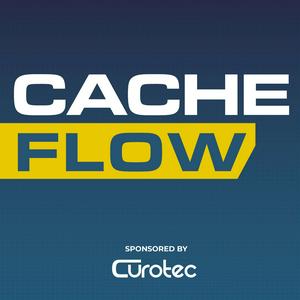E63: Tech-Savvy Banking: APIs, Fintech, and Future Finance
Meet Kent Landvatter, CEO of FinWise Bank, a financial haven for the fintech space. With 14 years at the helm, he shares intriguing insights from enabling FinTech platforms with API layers to navigating the complex web of regulation. Tune in for a deep dive into the symbiotic relationship between traditional banking and modern technology, from automated lending to combating money laundering and beyond.Here are a few topics we’ll discuss on this episode of Cache Flow Podcast.Kent's journey from traditional banking to FinTechFin Wise's robust SBA lending and tech stackHow APIs streamline FinTech lending operationsThe role of stable coins in modern bankingKent discusses regulatory relationships and AIResources:FinWise BankCurotec Connect with Kent Landvatter:LinkedInConnect with our host, Brian Dainis:LinktreeQuotables:05:11 - The thing that's been interesting to watch in SBA land, because I've been there for many, many years, is a lot of administrations will cut back on the subsidy or will increase the subsidy, you know, to, to save money or to, you know, expand small business lending. But SPA, and I don't have the actual data, but SPA is one of the few government programs that I believe actually at least breaks, even if not makes money for the government, because when someone does an SBA loan, part of what they pay for that SB loan, SBA loan is a fee that helps, you know, support the subsidy. So the subsidies really there as a backstop if the, if too many loans go bad, but a lot of those fees were being paid by banks and customers that are participating in the program. 05:11 - The thing that's been interesting to watch in SBA land, because I've been there for many, many years, is a lot of administrations will cut back on the subsidy or will increase the subsidy, you know, to, to save money or to, you know, expand small business lending. But SPA, and I don't have the actual data, but SPA is one of the few government programs that I believe actually at least breaks, even if not makes money for the government, because when someone does an SBA loan, part of what they pay for that SB loan, SBA loan is a fee that helps, you know, support the subsidy. So the subsidies really there as a backstop if the, if too many loans go bad, but a lot of those fees were being paid by banks and customers that are participating in the program. 14:07 - For the larger banks, I think SBA lending is just a step for them to bring a customer who's not ready for a regular commercial loan into the fold. Right? And then they'll try and put 'em into a commercial loan as soon as they can and sometimes pay off the SBA loan where they make money, the bank makes money both on the, on the premium and then, yeah. 'cause they'll sell these out to the marketplace and then they can re write that into a commercial loan. And I think that's generally what you see. But there are a handful of banks, one of ours being ours, being one of those that really focuses on this as a core business. 'cause if you think of the total SBA volume that's produced each year, it's probably a rounding air for a bank like Citibank or what have you. For banks like ours, it can be very meaningful. And so we've got a very deep SBA program and SBA department and we pride ourselves on fast turn times and being able to get the data together in a right way that helps a customer gather and understand what's happening. And, and so we're not always going back for more and more and more. And I think you're a strong SBA lenders, you know, focusing just more and more on that would probably be similar to this.15:32 - I think you might have more insight on this, but I think it, obviously the commercial lending terms typically are a little better than the SBA lending terms, but you know, then you have like covenants and stuff that you have to meet typically on the commercial side, whereas the SBA doesn't. And I think what I understand is, you know, it makes sense to look at commercial when you either have a strong collateral position that you can offer the bank or if you have, I don't like, I have a professional services firm, so there's like no collateral other than cash and ar. So I think what made sense there was to have like at least a few million in EBITDA to really take the commercial side more seriously.40:42 - But if we build an API that's customize, customizable by the FinTech where they can go in and optimize all that, they can say, if it's up to this time and the customer wants it this fast, use these rails and they can optimize the use of the rails because it's all on our system. And so they can push the money or receive the money any way they want, but push the money which is optimal for the customer and at the lease cost for the FinTech. And then when you add that to the, the lending side, receiving payments and so forth, it really gives a FinTech a lot more options of one stop shopping on the movement of the money and support of their customers.
